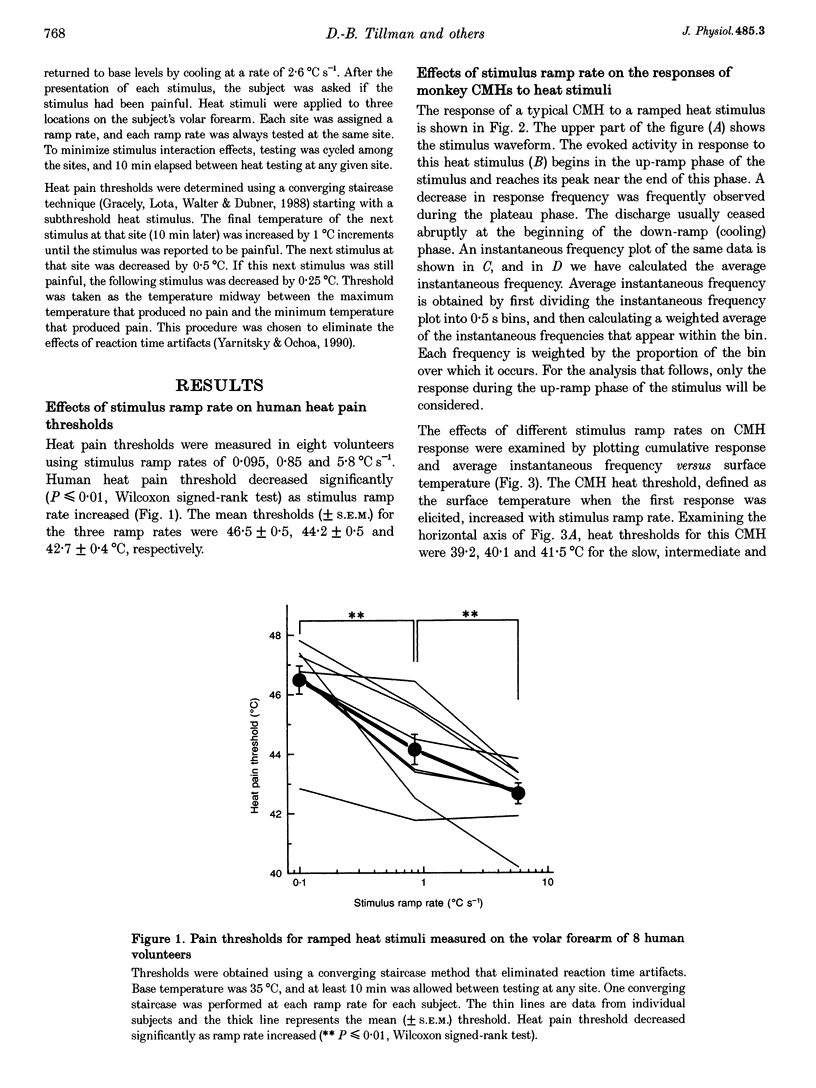Abstract
1. Ramped heat stimuli were used to compare the effects of rate of temperature change on the responses of monkey nociceptors and on heat pain threshold in human subjects. Recordings were made from twenty-five cutaneous C fibre mechano-heat nociceptors (CMHs) innervating the hairy skin in the anaesthetized monkey. Heat pain thresholds were determined on the volar forearm of eight human subjects using a converging staircase technique. 2. The heat pain threshold decreased as stimulus ramp rate increased. In contrast, the CMH heat threshold, defined as the surface temperature at which the first action potential occurred, increased as stimulus ramp rate increased. Thus, the properties of the heat stimulus that dictate heat pain threshold are different from the properties of the heat stimulus that govern the initiation of a response in nociceptors. 3. Peak discharge frequency of CMHs during the heat ramp increased with stimulus ramp rate. Heat pain threshold was correlated with achievement of a minimum discharge rate in nociceptors (0.5 Hz), rather than with the threshold for action potential initiation.
Full text
PDF







Selected References
These references are in PubMed. This may not be the complete list of references from this article.
- Adriaensen H., Gybels J., Handwerker H. O., Van Hees J. Latencies of chemically evoked discharges in human cutaneous nociceptors and of the concurrent subjective sensations. Neurosci Lett. 1980 Oct 20;20(1):55–59. doi: 10.1016/0304-3940(80)90233-5. [DOI] [PubMed] [Google Scholar]
- Bessou P., Perl E. R. Response of cutaneous sensory units with unmyelinated fibers to noxious stimuli. J Neurophysiol. 1969 Nov;32(6):1025–1043. doi: 10.1152/jn.1969.32.6.1025. [DOI] [PubMed] [Google Scholar]
- Bromm B., Jahnke M. T., Treede R. D. Responses of human cutaneous afferents to CO2 laser stimuli causing pain. Exp Brain Res. 1984;55(1):158–166. doi: 10.1007/BF00240510. [DOI] [PubMed] [Google Scholar]
- Campbell J. N., LaMotte R. H. Latency to detection of first pain. Brain Res. 1983 May 5;266(2):203–208. doi: 10.1016/0006-8993(83)90650-9. [DOI] [PubMed] [Google Scholar]
- Campbell J. N., Meyer R. A. Sensitization of unmyelinated nociceptive afferents in monkey varies with skin type. J Neurophysiol. 1983 Jan;49(1):98–110. doi: 10.1152/jn.1983.49.1.98. [DOI] [PubMed] [Google Scholar]
- Gracely R. H., Lota L., Walter D. J., Dubner R. A multiple random staircase method of psychophysical pain assessment. Pain. 1988 Jan;32(1):55–63. doi: 10.1016/0304-3959(88)90023-1. [DOI] [PubMed] [Google Scholar]
- Tillman D. B., Treede R. D., Meyer R. A., Campbell J. N. Response of C fibre nociceptors in the anaesthetized monkey to heat stimuli: estimates of receptor depth and threshold. J Physiol. 1995 Jun 15;485(Pt 3):753–765. doi: 10.1113/jphysiol.1995.sp020766. [DOI] [PMC free article] [PubMed] [Google Scholar]
- Torebjörk H. E., Ochoa J. L. Specific sensations evoked by activity in single identified sensory units in man. Acta Physiol Scand. 1980 Dec;110(4):445–447. doi: 10.1111/j.1748-1716.1980.tb06695.x. [DOI] [PubMed] [Google Scholar]
- Treede R. D., Meyer R. A., Raja S. N., Campbell J. N. Evidence for two different heat transduction mechanisms in nociceptive primary afferents innervating monkey skin. J Physiol. 1995 Mar 15;483(Pt 3):747–758. doi: 10.1113/jphysiol.1995.sp020619. [DOI] [PMC free article] [PubMed] [Google Scholar]
- Van Hees J., Gybels J. C nociceptor activity in human nerve during painful and non painful skin stimulation. J Neurol Neurosurg Psychiatry. 1981 Jul;44(7):600–607. doi: 10.1136/jnnp.44.7.600. [DOI] [PMC free article] [PubMed] [Google Scholar]
- Yarnitsky D., Ochoa J. L. Studies of heat pain sensation in man: perception thresholds, rate of stimulus rise and reaction time. Pain. 1990 Jan;40(1):85–91. doi: 10.1016/0304-3959(90)91055-N. [DOI] [PubMed] [Google Scholar]
- Yarnitsky D., Simone D. A., Dotson R. M., Cline M. A., Ochoa J. L. Single C nociceptor responses and psychophysical parameters of evoked pain: effect of rate of rise of heat stimuli in humans. J Physiol. 1992 May;450:581–592. doi: 10.1113/jphysiol.1992.sp019144. [DOI] [PMC free article] [PubMed] [Google Scholar]


